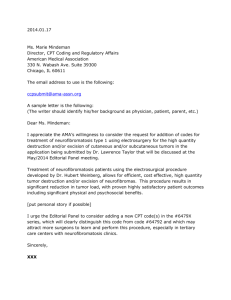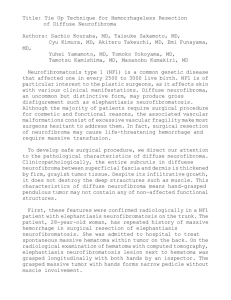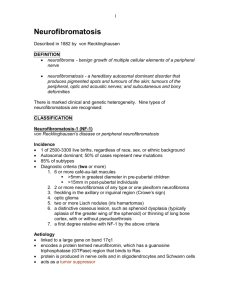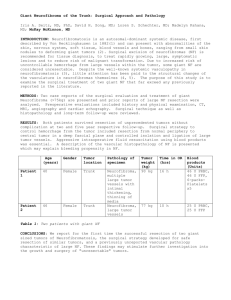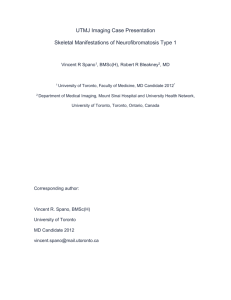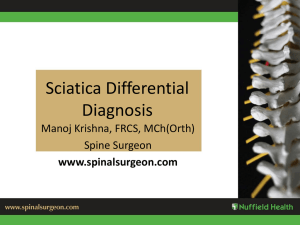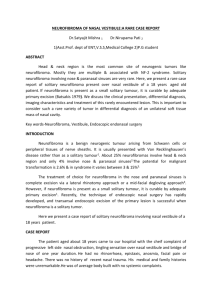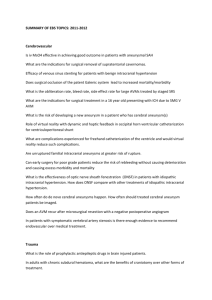Recurrent plexiform facial neurofibroma with impacted mandibular
advertisement
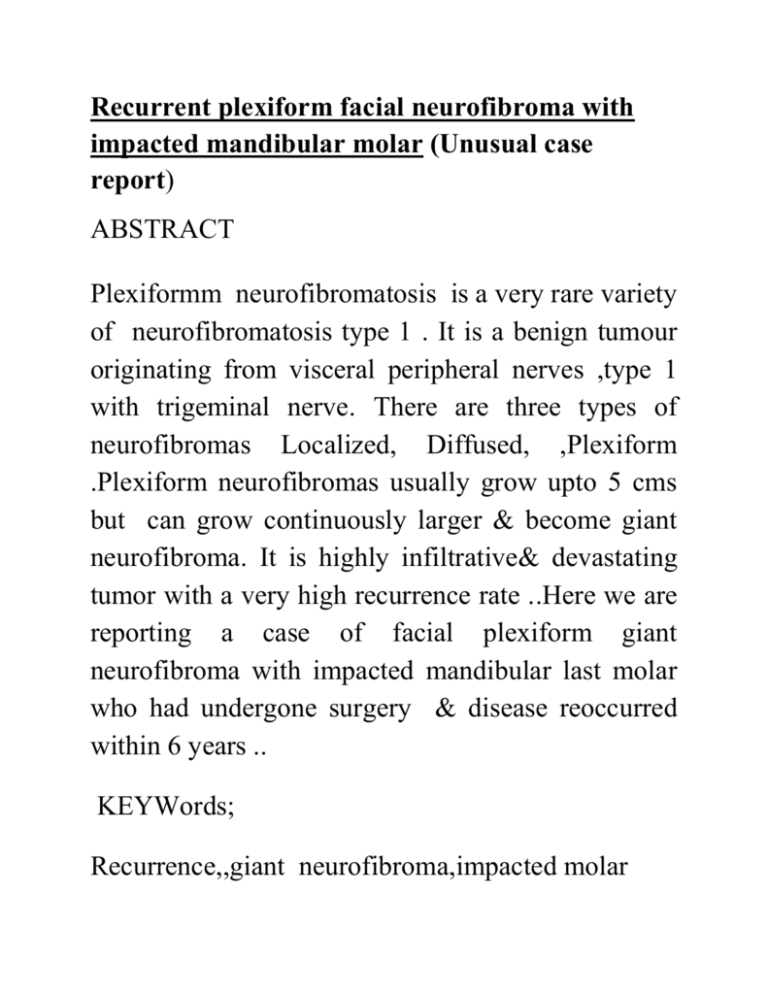
Recurrent plexiform facial neurofibroma with
impacted mandibular molar (Unusual case
report)
ABSTRACT
Plexiformm neurofibromatosis is a very rare variety
of neurofibromatosis type 1 . It is a benign tumour
originating from visceral peripheral nerves ,type 1
with trigeminal nerve. There are three types of
neurofibromas Localized, Diffused, ,Plexiform
.Plexiform neurofibromas usually grow upto 5 cms
but can grow continuously larger & become giant
neurofibroma. It is highly infiltrative& devastating
tumor with a very high recurrence rate ..Here we are
reporting a case of facial plexiform giant
neurofibroma with impacted mandibular last molar
who had undergone surgery & disease reoccurred
within 6 years ..
KEYWords;
Recurrence,,giant neurofibroma,impacted molar
INTRODUCTION
Neurofibromatosis is an autosomal dominant
disorder which affacts skin ,soft tissue nerves &
bones,it is neurocutaneous affecting almost every
organ of body & is of two types ,type 1& type 11.
Neurofibromatosis type 1 is an autosomal
dominenet genetic syndrome caused by mutation in
genes coding for neurofibromin [bhati].There are
three types of neurofibromas Localized, Diffused,
,Plexiform .Plexiform neurofibromas usually grow
upto 5 cms but can grow continuously larger &
become giant neurofibroma..[1] . .Giant
neurofibroma is poorly defiened term & is used to
describe a neurofibroma which grows to a
significant size. . . Plexiform neurofibromas are
benign tumours that originate from nerve sheath
cells or subcutaneous peripheral nerves , & can
involve multiple fascicles .. Plexiform
neurofibromatosis is a relatively common but potentially
devastating manifestation of neurofibromatosis type 1
(NF1). It produces very hideous deformity if the face is
involved & occur in as much as 30% of patients with
neurofibromatosis type 1[2]. .Massive plexiform
neurofibroma result in functional disability &
disfigurement & occur in as much as 30% of cases
of cases with type 1 neurofibromatosis . PNF
present at birth and often progress during early
childhood at growth rate & pattern which vary very
significantly & unpredictably. The condition can
cause disfigurement by pulling down of important
structures. Because of the large size of the tumors
and involvement of multiple fascicles of nerves, the
risk of neurological and functional destruction upon
tumour resection is very high. Surgical management
remains the mainstay of therapy, but in head & neck
region it is limited by infiltrating nature this tomour inhert
operative morbidity & high rate of growth tumor.[3]
Such neurofibromas infiltrate multiple tissue planes and
are thus much more difficult or impossible to resect.. .
Most cases require repeat surgery as complete
excision is generally not possible due to the
infiltrating nature of these tumors[4].Surgical
intervwntion is thus commonly postponed to as long
as possible..PNFS have a potential for transformation into
highly malignant peripheral nerve sheath tumours which occur
in approximately 5% of patients [5].
MATERIAL & METHODS
A
45 yrs pld male reported to the department of oral &
maxillofacial surgery indira Gandhi govt Dental college Jammu
with history of tooth ach . Patient had facial disfigurement with
skin folds hanging from face on left side.He had overhanging
folds of loose skin from face. Patient gave past history of a small
similar swelling in past which was operated 6 yrs back(Fig 1)
.s.As per history swelling recurred & increased progressively to
large giant size.On Physical examination face was disfigured
due to overhanging folds of skin in orbital & zygomatic region..
huge soft tissue swelling involving lft side mandible,nasolabial
fold. LT ,angle of mouth &,LT eye drooping down,LT eye
appeared smaller RT eye but Vision was not affected.There was
deviation of mouth to RT side completely (Fig 2,3,4 frontal &
lateral profile) Intraorally patient had soft tissue folds on left
mandibular posterior region ,with impacted mandibular
last
molar.. These mucosal folds were soft nontender (Fig 5). OPG
revealed radiolucency over LT side mandible w ,On.On left side
mandibular last molar was impacted & bone destruction on body
,angle region extending to ramus of mandible (Fig 6 7.patient
was not interested for treatment of fascial disfigurement & was
upset due to recurrence of lesion at much larger size than
before...AS per patient he was living happily without any
pychologic embarresment & had no functional or neurologic
problems even before surgery He had got his surgery done for
cosmetic or esthetic reasons only but unfortunately lesion
recurred to much bigger size than before RT side patient had
grossly decade mandibular first molar with pain, for which
patient had come to hospital.Extraction of first molar was done
under LA .
DISCUSSION
Plexiform neurofibroma is a rare type of generalized
neurofibromatosis ,which occur due to overgrowth of
neural tissue in the subcutaneous fat or deeper in
the body .these are considerd as hamartomas rather
than typical tumour[67[.PNF are benign peripheral
nerve sheath tumours ,often involving trigeminal or
upper cervical nerves[8] .they are diffused &
elongated fibromas usually seen in only 5-10 % of
patients with NF1[9].They originate from nerve
sheath cells & can involve multiple fasciclesPNF is a
rare type of generalized neurofibromatosis which
occurs due to overgrowth of neural tissue in
subcutaneous tissue .The diffuse & soft nature of
PNF is often compared with “a bag of worms”[7]..The
condition is autosomally dominant ,with variable
penetration & presents as multiple nodules of
varios sizes which are firm non tender ,often
associated with café au lait spots & spindle
deformities[10]. Café ul lait spots are pigmented
macules that may vary from light brown to dark
color .with irregular borders,can appear anywhere
on face but are less common on face[4]in the
present case there were no spots
.PNF can occur anywhere along a nerve & may
appear on the face [7] [11] orbit ,globe [12]or spinal
cord & frequently involve fifth ninth ,& tenth cranial
nerves[13]The condition can be quite disfiguring as
in our case. Symtoms can be ranging from
discomfort to extreme pain, neurologic deficits &
psycologic disturbences because of abnormal
anatomy[7] Where as in our case there was no pain,
irritation,discomfort neurologic deficit etc. The
tumour can cause intracranial pressure, seizure,or
cranial nerve abnormalities De Bella K et a [14] &
national institute of health concensus [15] reported
that many patient with NF1 (25-40%) often have
below average intelligence & 5-10 % have mental
retardation where as the present patient had
normal I,q or intelligence &was mentally fit.
Although skin is most predominantly involved
stomach kidneys,urinary bladder,heart,larynxare
also affected..In head & neck region scalp,cheek
neck oral cavity[4]
.Bone involvement may be due to both external
resoption & internal osteolytic defects.External
resoption may be due to pressure applied on the
bone by the neurofibroma [16].as is in our
case,radiographically bone resoption is seen in
body & ramus region.Skeletal involvement is seen in
40% of the cases scoliosis being most common
feature.[17]TMJ may be involved,oral cavity is
involved in 66-72% of the cases,there is lengthening
of fungiform papilla in 50% of the cases with PNF.IN
our patient tongue was normal,.In 25%0f PNF cases
oral neurofibromas are seen , hard or soft tissue of
oral cavity can get affected.Most common lesions
are seen on tongue{4,5,9,12,13 from 13yrs old]In
our case gingival is involved ,which is very
uncommon location.Shapiro et al reported that gum
involvement in PNF1 is 5 %[18].Localized oral
neurofibroma usually appear as asymptomatic
nodules covered by normal mucosa .[4,7,9,12] as in
our case .however when adjacent cranial
nerves,they can affect the motor functions of facial
,hypoglossal nerve,or sensitivity of trigeminal
nerve.[4,7,9]Gingival neurofibromas can cause
malposition of teeth or impaction[4, 12] like the
present case & also may show facial disfigurement
due to hyperplasia of mandible or maxilla ,malar
bone & TMJ..Facial pnf may also cause facial
assymmtry as in our case.
Radiologic findings include widening of mandibular
cannal,mandibular foramen& mental
foramen[12].neurofibromas are rarely intraosseous
&show unilocular well defiened radiolucencies.[9
10].In our case there was nodular intraoral nodules
,of nomal mucosa color,tongue was not
involved,bone destruction on body ,angle & ramus
of mandible with impacted last left mandibular
molar,which is not reported till now.Neurofibromas
usually grow slowly without pain& can be
symptomatic at birth or through time.Most cases
require repeat surgery as complete excision
generally is not possible due to the infiltrative
natures of these tumors [3]Such neurofibromas
infiltrate multiple tissue planes & are thus much
more difficult &impossible to resect[4].Partial or
total resection of these lesions can be treatment of
choice to solve aesthetic or functional
problems.Total resection with 1 cm nomal margin is
treatment of choice for accessible& small
tumours[8].but it is advisable to wait until growth is
complete to prevent recurrence[7,9,12,13]
Clinical management for the PNF requires a
multidisciplinary approach. However current
treatment options for PNF are limited to surgical
intervention .Resection is performed when tumour
is severly disfiguring or severly compromises
functionality.[19].Complete resection is often
difficult because of extensive & infiltrative nature
of the lesion[20]Needle et al [3] analyzed the
largest series of surgically managed PNFS&
demonstrated that 54% recurred within a 10 years
period, with the greatest risk of recurrence found in
lesion involving the head & neck region.Resection &
debulking of invasive PNF is however associated
with high rate of recurrence .In one pediatric series
,resection developed recurrence in 20% &
incomplete had a recurrence in upto 45%of
cases[3].one of the limiting factor is vascularity of
these lesions& abnormal tendency to bleed.These
tumours bleed profusely during surgery because of
friable nature of neo vessels.Surgical management
remains the mainstay of treatment for these
tumours but functional disturbances are almost
inevitable while resecting tumours involving the
head &neck region[21]No chemotherapeutic agent
has been yet identified that reduces the size of
these tumours[22].in our case recurrence of tumour
took place after 6 yrs of initial resection ,tumour
grew aggressively ,with more functional & cosmetic
deformity.IN our case recurrence took place after 6
years of resection which caused much Facial
disfifutrment than before
Conclusion
Neurofibromas infiltratrate multiple tissue planes
,&Due to the infiltrative nature of these tumours
especially in head &neck region are much more
difficult or impossible to resect .Extensive surgical
procedures have to be weighed against functional
disturbences that are almost inevitable while
resecting invasive neurofibromas in head & neck .
;.Surgery should only be undertaken after explaining
the patients functional disability after extensive
resection of facial tissues, postoperatively,& high
rate of recurrence .Due consideration should be
given to the possible psycologic problems & ragular
counseling sessions should be given to the patients .
BIBLIOGRAPHY
REFERENCES
1 D.Coakley, & MD Atlas “diffuse neurofibroma obstructing external auditory meatus “journal
of Laryngology & otology vol,111,no,2,pp.145-147,1997,view at scoups.
2 Hussan SM ,Huges RA.London;Champan &Hall Medical ;1994.The
neurofibromatosis ;A pathogenetic &clinical overview
3 Needle MN,Cnaan,DattiloJ,Chatten J,PhillipsPC,Shochat S,et al.Prognostic
sighns in surgical management of Plexiform neurofibroma;the children hospital of
Phildelphia experience,1974-1994.J Pediatr,1997;131;678-82[pubmed]
4 Friedrich RE,Schmelzle R HartmannM,,Funstere C, MauterVF,Resection of
small plexiform nerofibroma in neurofibromatosis tyre 1 children world .J surg
onco,2005;3;3-6[PMC free article] [pubmed]l
5 B.R.Korf “Malignancy in neurofibromatosis type 1 “Onchologists ,vol 5,no 6,pp
plexiform neurofibroma in a child with neurofibromatosis type 1 ;A case
report 477-485 ,2000 view at scoup
6 Sengupta SP,Tumours & cysts ,IN;Long and short cases in surgery ,first ed ,New
Centre book Agency publication,Calcutta ,1996;39-75
7 Patil K,Mahima VG,Lahari K,Facial.J Indian Soc Pedodontics Prevent
,Den.2007;25(1);30-35
8 Kumar SS,Kumar DM,Thirunavukuarasu R.Diffuse plexiform neurofibroma.j
Indian journal of surgery 2010 july; 72 (suppl 1);363-4
10 Kam JR HelmTN,Neurofibromatosis,(von recklings disease ) e medicine
.available at http;//www.emedicine.com /DERM/topic 287.htm ,Accessed july
28,2008
11Sienkiewicz H, Wójtowicz PM. A case of plexiform
neurofibroma of the face. Otolaryngol Pol. 1985;
39(3):253-256
12. Davis FA. Plexiform Neurofibromatosis (von
Recklinghausen's Disease) of the Orbit and Globe,: with Associated
Glioma of the Optic Nerve and
Brain: Report of a Case. Trans Am Ophthalmol
Soc. 1939; 37:250–271.
13 Ferrozzi F, Zuccoli G, Bacchini E, Piazza P,
Sigorini M, Virdis R. Extracerebral neoplastic
manifestations in neurofibromatosis 1: integrated
diagnostic imaging. Radiol Med (Torino) 1998;
96:562-569.
14DeBella K, Szudek J, Friedman JM. Use of the
national institutes of health criteria for diagnosis of
neurofibromatosis 1 in children. Pediatrics. 2000;
105(3 Pt 1):608-614
15. National Institutes of Health Consensus
Development Conference. Neurofibromatosis.
Conference statement. Arch Neurol. 1988; 45(5):
575-578.
16 Marx R E ,STERN D ,Oral & Maxillofacial pathology ,ARationale for diagnosis &
treatment illionoises quintessence publishing co IN 2003
17 Bhatia RS,A khosla, R. Dhir,R.BHATIA & A.K.Banerji,” “giant lumbosacral nerve
sheath tumrs” Surgical neurology ,vol.37,n0.2,pp118-122 ,1992 view at
publisher,google scholar,view at scoups
18 Garcia D Marcos J A, Dean Ferrer,A ,Allamilos-Granodos F,Ruis Masera JJ,Gracia D Marcos
MJ,Vidal Jimenez et al “ Gingival neurofibroma in case of neurofibromatosis type
1,med oral patho,oral cir buccal 2007;12,E 287-91
19 S. S. Ergün, E. Emel, S. Karabekir, and N. Büyükbabani, “Extracranial diffuse
neurofibroma with intracranial extension,” Plastic and Reconstructive Surgery, vol.
105, no. 2, pp. 801–803, 2000. View at Publisher · View at Google Scholar
20 E. J. van Zuuren and A. N. Posma, “Diffuse neurofibroma on the lower back,”
Journal of the American Academy of Dermatology, vol. 48, no. 6, pp. 938–940,
2003. View at Publisher · View at Google Scholar · View at Scopus
.[21] . Kleinhues P, Cavenee WK. Lyon: IARC Press Lyon; 2000. Tumours of
the nervous system. In World Health Classification of Tumours
.
22 . Wise JB, Patel SG, Shah JP. Management issues in massive pediatric facial
plexiform neurofibroma with neurofibromatosis type 1. Head Neck. 2002;24:207–
11. [PubMed]
.
Fig 1 Scar mark of previous surgery
Fig 2 Facial plexiform neurofibroma (lateral
profile)
Fig 3 front profile
Fig 4 Deviation of facial structures to RT
side
f
Fig 5 Intra oral mucosal nodules
Fig 6 Bone destruction Lt ramus angle &
body
Fig 7 impacted mandibular third molar &
missing 2nd molar
